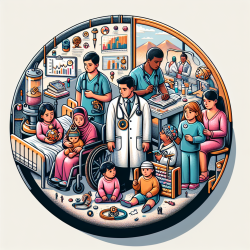Introduction
In the ever-evolving field of speech-language pathology, the integration of data-driven methodologies is crucial for enhancing therapeutic outcomes. A recent study, "From Natural Resources Evaluation to Spatial Epidemiology: 25 Years in the Making" by Pierre Goovaerts, offers groundbreaking insights into the application of geostatistics in spatial epidemiology. This research provides valuable tools and concepts that can be adapted to improve practices in speech-language pathology, particularly in educational settings.
Understanding Spatial Epidemiology
Spatial epidemiology involves the study of the spatial distribution of health outcomes and their determinants. This field has gained traction due to its ability to integrate environmental, socio-economic, and genetic data to understand health patterns. Goovaerts' research emphasizes the importance of adapting traditional geostatistical tools to address the unique challenges of epidemiological data, such as heteroscedasticity and uneven spatial support.
Key Takeaways for Practitioners
- Interdisciplinary Approach: The study highlights the value of interdisciplinary research. Practitioners should consider collaborating with experts in fields such as environmental science and epidemiology to gain a comprehensive understanding of factors affecting child health and development.
- Data-Driven Decisions: By employing geostatistical methods, practitioners can make more informed decisions based on spatial data. This approach can be particularly useful in identifying areas with higher needs for speech-language services.
- Adaptation of Tools: The adaptation of tools like semivariogram and kriging for epidemiological data is crucial. These tools help in visualizing and analyzing spatial patterns, which can be applied to assess the distribution of speech and language disorders in different regions.
Implementing Research Outcomes
Practitioners can implement the findings from Goovaerts' research by incorporating spatial analysis into their assessment and intervention strategies. For instance, mapping the prevalence of speech disorders across different school districts can help allocate resources more effectively. Additionally, understanding environmental and socio-economic factors can aid in developing targeted interventions.
Encouraging Further Research
The study underscores the importance of continuous research and innovation. Practitioners are encouraged to explore further research opportunities in spatial epidemiology and its applications in speech-language pathology. By doing so, they can contribute to the development of more effective and efficient therapeutic approaches.
Conclusion
Integrating spatial epidemiology and geostatistics into speech-language pathology can significantly enhance the understanding and treatment of speech and language disorders. By leveraging data-driven insights, practitioners can improve outcomes for children and make informed decisions that cater to the specific needs of their communities.
To read the original research paper, please follow this link: From Natural Resources Evaluation to Spatial Epidemiology: 25 Years in the Making.










